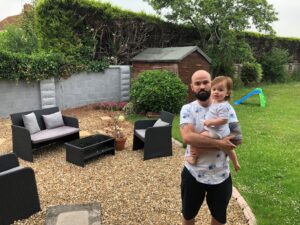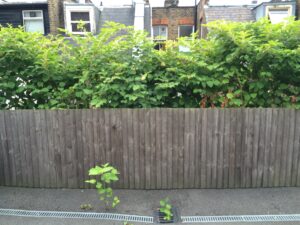Japanese knotweed: Just one fifth of people can identify UK’s most invasive plant
Just one fifth of people can identify UK’s most invasive plant, as bindweed is most commonly mistaken for Japanese knotweed.
Only 22% of British adults can correctly identify Japanese knotweed from other plant species commonly found in British gardens, leaving almost four fifths of people in the UK extremely vulnerable to the risks posed by the UK’s most invasive plant, reveals new research from YouGov and invasive plants specialist Environet.
From a photographic plant identification parade, the survey of over 2,000 GB adults found that approximately half (49%) mistakenly identified other common garden plants such as bindweed, Houttuynia, Horsetail, ivy, Russian Vine and peony as knotweed.
Bindweed, a troublesome but relatively harmless perennial plant often found snaking its way over hedges and fences, was most commonly mistaken for Japanese knotweed (selected by 16% of respondents), followed by Houttuynia (4%) and cottage garden favourite peonies (4%), which when emerging from the ground look similar to the red spear-like shoots of knotweed.
Japanese knotweed is most easily recognisable in early spring, with only very small numbers of people able to recognise the distinctive green heart-shaped leaves that sprout in early summer (5%), the carrot-like rhizome (4%) or the distinctively speckled bamboo-like canes (4%).
Japanese knotweed is now well established across the UK, with particular hotspots in Bolton, Merseyside, Reading and London’s Shepherd’s Bush, according to Environet’s live Japanese knotweed heat map, Exposed. The research indicates that knotweed now affects approximately 4% of homes either directly, that is, growing in a property currently lived in (2%) or indirectly, growing on a neighbouring property (2%).
Despite challenges identifying the plant, people are much better informed about the risk of damage it poses to their homes, with 56% aware that it can grow through patios, causing them to crack and lift, 47% aware it can grow through an asphalt driveway and 43% knowing knotweed can grow through brick walls, causing them to break apart and eventually collapse. Certain myths still persist, however, with 47% believing knotweed can grow directly through concrete – when in fact it can only exploit existing cracks and weaknesses in it. Just over a third of people (34%) mistakenly believe knotweed can cause a building to collapse; it is well known that it can cause damage, especially if a severe infestation is left unchecked for several years.
For the first time, it’s now possible to insure against damage to property, as well as the cost of treating potential regrowth, as part of Environet’s insurance-backed guarantee. Mortgage lenders insist that a professional treatment plan is in place with an insurance-backed guarantee in order to offer a loan on the property.
Nic Seal, Founder and MD of Environet, said:
“The general public’s ability to spot Japanese knotweed is worryingly low, particularly considering around 4% of our homes are affected, making them difficult to buy and sell and causing disputes between neighbours which can be unpleasant and costly to resolve. Homeowners and buyers keen to avoid a run in with this highly destructive and invasive plant should ensure they know what to look out for at different times of year, from the dark red spears that emerge in March or April to the lush green leaves of summer and the dead-looking canes left standing by early winter.
“Awareness of the damage caused by knotweed if it’s left unchecked is thankfully much higher, and people are right to be concerned. Knotweed is best dealt with quickly, before it has a chance to become established and spread.”
David Botley FRICS, of BotleyByrne Chartered Surveyors, said:
“If it’s visibly growing, Japanese knotweed should be identified by a chartered surveyor during a survey, which combined with the seller’s legal obligation to declare if their property is affected, means buyers are relatively well protected. However, encroachment from neighbouring land can happen at any time and it’s not unusual for knotweed to lie dormant beneath the ground for several years before suddenly emerging, particularly if the ground is disturbed. It’s a good idea for homeowners to know what knotweed looks like and keep an eye out for any new unidentified plants, in order to protect their home and investment.”
Case study – Joe Wigzell, Weston-super-Mare, Somerset
Joe Wigzell (37) bought a bungalow close to Weston-super-Mare earlier this year which was affected by Japanese knotweed. Joe knew very little about knotweed and wouldn’t have recognised the plant himself, but the estate agent told him about it during a property viewing. Joe was not overly concerned until he spoke with his mortgage lender who advised him that evidence of a professional treatment plan was required in order to proceed with the mortgage application. The infestation was already being professionally treated with herbicide, but Joe was concerned that this is a ‘control’ method and he wanted the plant gone for good.

Case study Joe Wigzell and family in the garden of their new home.
Following a negotiation, the seller agreed to factor the cost of a full excavation of the knotweed into the sale price, meaning Joe was confident in proceeding with the transaction. Environet recently excavated the Japanese knotweed using its Resi-DigOut™ method, which filters the knotweed rhizome from the soil and returns the clean soil to the ground, completely removing the plant in the most environmentally friendly method available.
Joe Wigzell said:
“Before buying my new home I didn’t know anything about Japanese knotweed and the damage it can cause to properties if left to grow unchecked. After doing some research, I realised it can be a serious issue. Knotweed wasn’t a deal breaker for me though, as long as the seller agreed to cover the cost of completely removing the plant – which thankfully they did.
“Herbicide treatment is really a halfway house, and considering we plan to extend the property, which could potentially awaken the plant from dormancy, for me excavation was the only option. I now have peace of mind that the problem has been dealt with and an insurance-backed guarantee to prove it. Although I will still be required to declare that knotweed was present when I come to sell, I don’t anticipate there being any problems selling the property in the future.”

Japanese knotweed in summer (Credit Environet UK)
Environet offers a free identification service to anyone who is concerned about a suspicious plant growing in their garden. Just email a photo to [email protected] for expert analysis.
Kindly shared by Environet UK


















